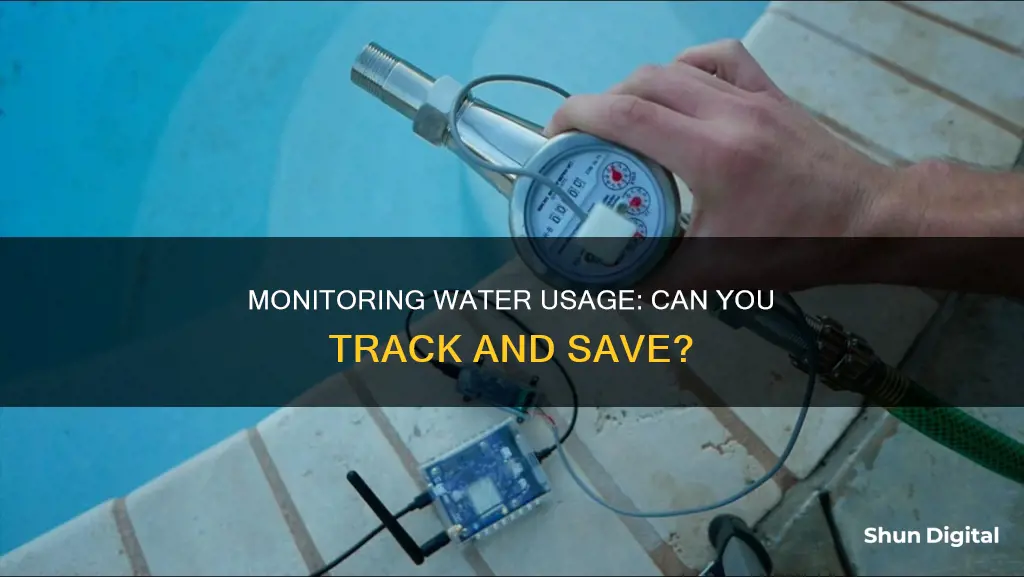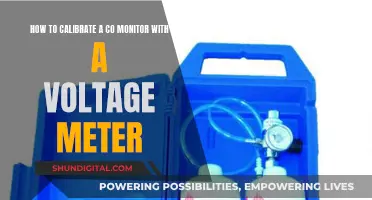
Water is a precious resource, and with access to plentiful clean water, many of us don't think to track our water usage. However, monitoring water consumption is important for several reasons. Firstly, it raises awareness of how water is used, allowing us to identify ways to reduce consumption and waste. Secondly, tracking water usage can provide valuable insights into potential plumbing issues, such as leaks, and help homeowners plan for necessary upgrades to their plumbing system and fixtures. By installing water monitors or monitoring systems, homeowners can gain precise data on their water usage, detect leaks early on, and even control their water usage through budgeting and notifications. These systems not only help conserve water and save money on utility bills but also protect homes from potential water damage caused by undetected leaks.
| Characteristics | Values |
|---|---|
| Traditional Methods of Water Monitoring | Reading the mechanical water meter installed by the water utility company |
| Downsides of Traditional Methods | Inaccurate due to human error; inefficient and time-consuming; lack of real-time data |
| How to Monitor Water Usage in 2024 | Smart water meters; Water Flow Meter with AI-Enhanced Monitoring; Smart Infrastructure |
| Online Water Monitoring | Digital meters that transmit information to utility providers and homeowners |
| Wireless Water Monitoring | An LCD display of water consumption; Smart water meters |
| Track Each Tap's Water Usage | Devices for tracking water use from each faucet, hose, and pipe in the home |
| Water Flow Meter | AI-powered dashboard that analyzes water usage in-depth and suggests areas for water conservation |
| Smart Infrastructure | Technologically advanced pipes and valves that automate and optimize water flow according to real-time demand |
What You'll Learn

Online water monitoring
The traditional water monitoring process involves utility officials manually reading mechanical water meters installed by water utility companies. This approach is prone to human errors and only provides monthly readings, making it challenging to identify issues like leaks promptly.
Additionally, online water monitoring platforms like Dropcountr connect to local water company databases, providing real-time updates on water usage. These platforms also serve as an early warning system for potential plumbing issues.
The benefits of online water monitoring extend beyond individual homeowners. On a larger scale, water companies employ various methods, such as district metering and advanced metering infrastructure (AMI), to monitor water distribution and consumption across their networks. This data helps them detect leaks and improve water conservation efforts.
The availability of real-time data through online water monitoring empowers individuals, communities, and water companies to make more informed decisions, promote conservation, and efficiently manage this precious resource.
Monitoring Hydro Usage: Smart Metering and Water Efficiency
You may want to see also

Wireless water monitoring
One example of a wireless water monitoring solution is the Flume 2 Smart Home Water Monitor, which connects to your phone and voice assistants like Amazon Alexa. It offers leak detection and whole-home water usage monitoring without requiring any plumbing work or wiring. Another option is the Water Monkey by Connected Sensors, which provides minute-by-minute water usage tracking and real-time notifications for leaks or irregularities.
These wireless water monitoring systems empower users to make informed decisions about their water consumption, encouraging more sustainable practices and enabling them to identify potential issues before they become costly problems. The availability of real-time data also promotes conscious water use and helps in achieving conservation goals.
Monitoring Data Usage: Tracfone's Easy Steps to Track
You may want to see also

Track each tap's water usage
There are a variety of devices available that can help you track the water usage of each tap in your home. These devices can help you become more conscious of your water usage and encourage you to find ways to reduce your water footprint.
One such device is a high-tech garden hose nozzle that displays water usage on an LCD screen. This allows you to see the amount of water you are using in real-time, which can motivate you to find ways to lower your water consumption. For example, you might be inspired to use less water when washing your car or feeding your vegetables.
Another innovative product that has been generating buzz in gadget blogs is the Koolhaus faucet. This unique-looking device tracks water usage with an LCD screen and sends the data directly to your computer. This allows you to monitor your water usage over time and make more informed decisions about your water consumption habits.
Additionally, you can use Dropcountr, which connects to your local water company's database and provides real-time updates on your exact water usage. This service not only helps you track your consumption but also alerts you to potential plumbing leaks, allowing you to take prompt action and avoid water wastage.
These devices and applications offer convenient and accessible ways to track each tap's water usage, empowering you to make more sustainable choices and contribute to water conservation efforts.
Deltek's Internet Monitoring: What You Need to Know
You may want to see also

Smart water meters
The advantages of smart metering are significant. Firstly, it offers an accurate and timely measure of water consumption, improving upon the inherent inaccuracies of manual readings. Secondly, smart metering enables improved leak detection and water loss prevention. By detecting leaks in real-time, consumers can address issues promptly, reducing water waste and potential property damage. Thirdly, smart metering provides real-time monitoring of water usage, allowing consumers to set alerts and conservation goals, leading to more conscious water use.
Smart metering technology can be integrated with irrigation systems, optimising water usage for landscaping and agricultural purposes. By using smart irrigation controllers and sensors, consumers can make significant water savings in areas where irrigation is a major consumer. Additionally, smart meters can be used to track water consumption trends over time, allowing building owners and developers to identify opportunities for cost savings and implement water conservation measures.
The use of smart water meters is becoming more prevalent as municipalities and building owners seek ways to reduce water waste and promote sustainability. While there are challenges, such as deployment and maintenance costs, the benefits of smart metering are clear. As the world prioritises sustainability and water conservation, smart metering technology is expected to become even more widespread, revolutionising the way we manage our precious water resources.
Monitoring Data Usage: Tips for Managing Home Internet Plans
You may want to see also

Water flow meters
The AI-enhanced monitoring system can identify trends, predict future usage, and suggest ways to conserve water. This dynamic response to water usage patterns ensures that adjustments are made for optimal efficiency. Water flow meters are especially useful for identifying leaks or irregularities, providing real-time notifications to prevent water wastage and potential property damage.
There are various types of water flow meters available, each with unique features and applications:
- Multi-Jet Water Meters: These meters are designed for inline applications and are installed in the flow path of your media. They are commonly used in residential settings.
- Positive Displacement Water Meters: Another type of meter for inline applications.
- Pulse Output Water Meters: These meters provide data through pulse output signals.
- Encoded Water Meters: Encoded water meters offer a more secure form of data transmission.
- Ultrasonic Water Meters: This type of meter uses ultrasonic technology for measurement and data collection.
- "Smart Home" Water Meters: These meters are part of a smart home ecosystem, often connected to smartphones or smart home hubs.
- Cubic Feet Water Meters: Designed to measure and display water consumption in cubic feet.
- Low Flow Water Meters: Specifically designed for low-flow applications, such as leak detection.
- Vertical Install Water Meters: Meters that are installed vertically, often in spaces with limited horizontal space.
- Garden Hose Water Meters: Meters designed for garden hose applications, helping monitor outdoor water usage.
- Automatic Shut-off Water Meters: These meters have an automatic shut-off feature, useful for leak prevention.
- Digital Flow Meters: Meters that feature digital displays and interfaces for data reading.
- Paddle Wheel Flow Meters: Using a paddle wheel mechanism to measure flow rate.
- Oval Gear Flow Meters: Employing an oval gear system to accurately measure water flow.
Monitoring JVM Heap Usage: Practical Tips for Performance Optimization
You may want to see also
Frequently asked questions
Monitoring your water usage can help you detect leaks, plan for plumbing upgrades, and conserve water. It also helps you save money on your water bill and lower your utility expenses.
There are a few ways to monitor your water usage. You can use your monthly utility bill readings to assess your water consumption. You can also install a water monitoring system, which can give you precise readings for your entire household or by fixture.
Some popular water monitoring systems include the Flume 2 Smart Home Water Monitor, StreamLabs Monitor, and Flo by Moen Smart Water Shutoff.







